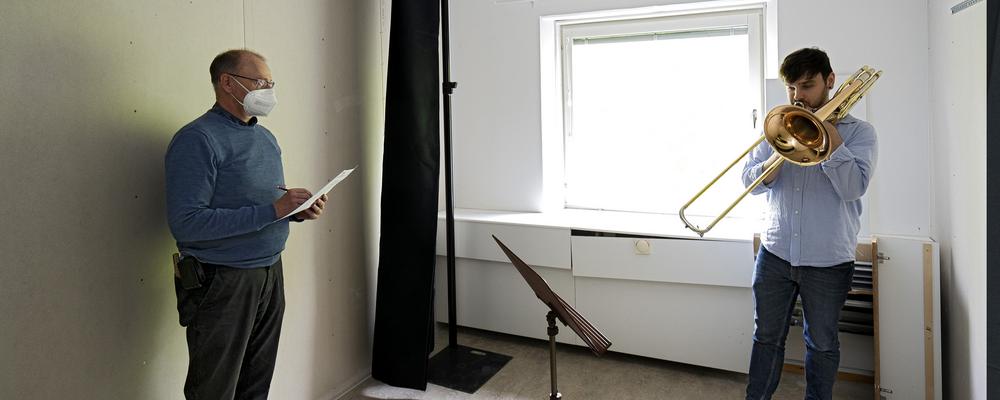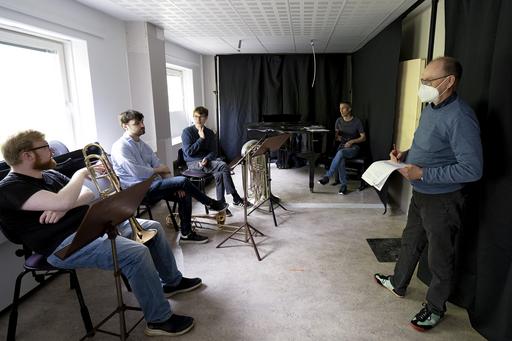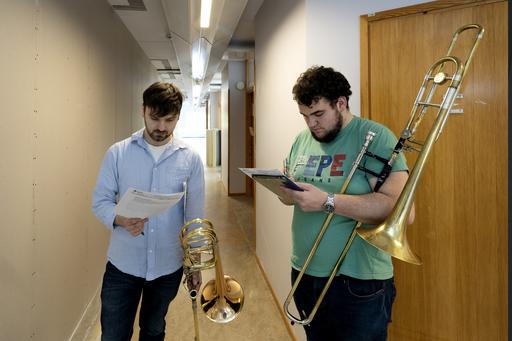
Students test sound at alternative facilities
As a part of the process of preparing alternative rooms for practice and rehearsal during the building process, many different groups of music students were invited to take part in various tests of the facilities at Eklandagatan 86, where most of the music programmes will be relocated temporarily.
Jørgen Simarud Stabell and Sergi Sirvent are trombone students from the Master programme of Fine Arts in Music with Specialization in Orchestra Performance. This interview was conducted with them shortly after a sound test they and two other brass instrument students participated in with acoustic consultants from the company Artifon.
What have you been doing here today?
Sergi: We are testing middle-sized rooms for brass. We play different excerpts with piano, forte and fortissimo passages. After that we write an attest and discuss all the ideas. The technicians ask if we have another idea for improving the rooms. I am a musician; I play and I have my thoughts, and I try to explain my feelings to the technicians in order for them to do a better work.
Jørgen: We’ve been testing with three different acoustic settings: without anything, with curtains, and with diffusors. Just to see how we can make them work for us.

What about the outcome of your work today? Do you think you have been listened to? Do you think the result will be good?
Sergi: Yeah, I think so. I think this kind of experimental work, it’s a really a good result and I hope that next year when the school moves here, we can see all the results we discussed now in the building. All these comments help the technicians do better work. And I hope they can do good work with the building – for us: all of this is for the students.
Jørgen: To be honest, the rooms we tried were a bit too loud, too small for us – three trombones and a tuba make quite a lot of sound. We are the loudest instrument group, we’re the ones that have the most special needs. So, for strings and woodwinds it will be easier, I think. But it seems they have pretty good ideas on how to, at least make them liveable. They are building like 300 of these diffusors and put in curtains so it actually can take down the decibel-levels quite a bit. I think it’s very promising.

Do the rooms meet your needs for you to be able to develop when practicing and rehearsing?
Sergi: It’s not the best room for playing but I think it’s a really good room for practicing. Concerts or public performances will be in other buildings. I think this is fine for studying. It’s important to practice in different acoustics. In some situations you need to instantly adjust to a new surrounding and play with your best sound and technique. And therefore, I think it’s good being able to change conditions with screens and curtains.
Why is the room you practice in important?
Jørgen: In many ways the room allows us to hear ourselves. I mean we stand in a room practicing 5-6 hours a day, so it’s quite important that we can hear what comes out of our bell, what we sound like. But also, that it is healthy for us to stay in that room and practice.
When you say healthy you mean decibel?
Jørgen: Yeah, especially decibel-wise and also, we talked about rooms with carpets and how they are very dry. And I think about when I’m practicing, those kinds of rooms can hurt my playing. So, rooms can actually impact your playing in quite a big way. If you have rooms with no reverb, you’ll end up never learning how to project. Or if you have rooms with way too much sound, you’ll end up projecting too little, because you never get to practice in a room that’s similar to a room you will play concerts in. Which is quite important.